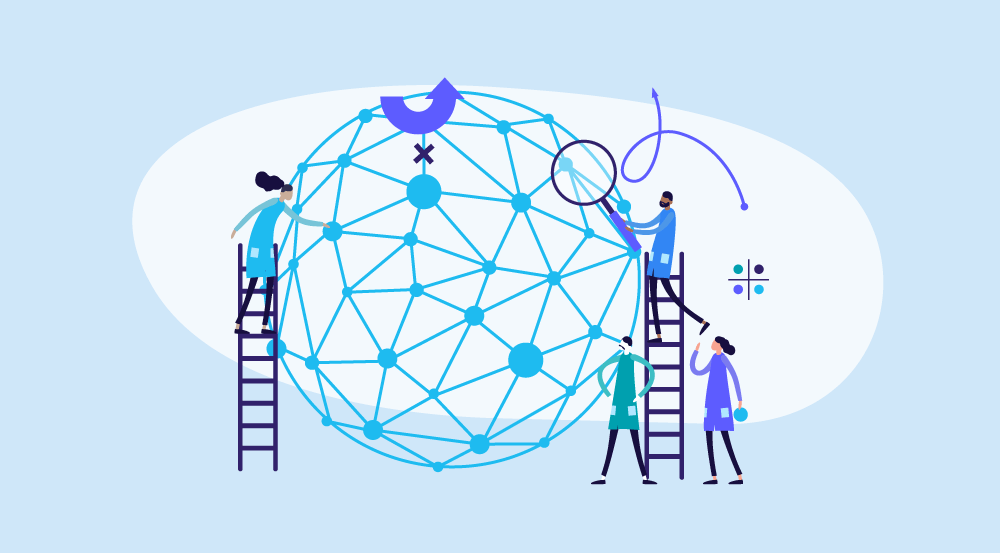Employee experience is a big deal in human resources.
From companies’ perspective, it’s equally important since doing so would give them a better understanding of how the employees feel about working there.
Employee experience is a fancy way of saying how employees see their interactions with the company.
It starts from when they first applied for the job and goes all the way until they leave.
When employees have a good experience, they feel more engaged.
And when they're more engaged, they're also more productive. It's a win-win situation.
Not only that but engaged employees also create positive customer experiences. And positive customer experiences are what builds customer loyalty.
So, it all comes full circle.
But that’s not all.
In this post, we’ll double down on the employee experience roadmap from different aspects – so much so that by the end of it, it’ll be easier for you to get a sense of direction and the strategies you need to incorporate into your organization.
Let’s get started.
What Is Employee Experience Roadmap?
An employee experience roadmap is a strategic plan that outlines the various initiatives and actions an organization intends to undertake to enhance the overall experience of its employees throughout their employment journey.
It is a forward-looking approach that focuses on creating a positive and engaging work environment, fostering a strong company culture, and aligning employee experiences with the organization's values and goals.
The employee experience roadmap typically includes a series of steps, milestones, and goals that an organization plans to achieve over a specified period.
These steps may cover areas such as onboarding, career development, training, feedback mechanisms, work-life balance, recognition programs, employee benefits, and more.
The roadmap's ultimate goal is to create an exceptional employee experience that results in improved job satisfaction, higher productivity, increased employee retention, and a positive impact on the company's overall performance.
Importance of an Employee Experience Roadmap
Talent Attraction and Retention
In today's competitive job market, attracting and retaining top talent is crucial for organizational success.
A well-crafted employee experience roadmap can act as a powerful tool for attracting talented individuals to the company and ensuring they stay engaged and committed in the long run.
Employee Engagement
Engaged employees are more likely to be motivated, proactive, and committed to their work.
A thoughtful roadmap helps create an environment where employees feel valued, supported, and connected to the company's mission, fostering higher levels of engagement.
Organizational Culture
Employee experience plays a significant role in shaping an organization's culture.
A positive culture promotes collaboration, innovation, and a shared sense of purpose, leading to a more cohesive and high-performing workforce.
Increased Productivity
When employees feel satisfied and motivated, they tend to be more productive and focused on their tasks.
A roadmap that addresses the pain points and aspirations of employees can boost overall productivity.
Employee Well-being
Prioritizing employee well-being through the roadmap can lead to reduced stress, improved work-life balance, and better mental and physical health, resulting in a more sustainable and healthier workforce.
Customer Experience
Satisfied and engaged employees are more likely to deliver excellent customer service.
A positive employee experience often translates into a positive customer experience, improving overall customer satisfaction and loyalty.
Adaptation to Change
A flexible and adaptive employee experience roadmap can help organizations navigate through changes more smoothly, whether it's due to technological advancements, market shifts, or other disruptions.
Employee Empowerment
A well-defined roadmap may include opportunities for employee development, skill-building, and career advancement, empowering employees to take charge of their professional growth and development.
The Essential Stages of Employee Experience That You Need To Know
A roadmap goes through 6 stages of employee experience.
All of these are essential to implementing different strategies for harnessing optimal productivity and overall morale in any thriving company.
Here’s a quick rundown of the 6 important stages of employee experience:
1. Attraction and Recruitment
An example of employee experience begins even before an individual becomes an employee.
- This stage focuses on attracting potential candidates to the organization and ensuring that the recruitment process is positive and efficient.
- It involves creating an employer brand that reflects the company's values, culture, and work environment, which can help attract candidates who align with the organization's vision.
- During the recruitment process, organizations should aim to provide a clear and transparent picture of the role and the company, offering a realistic job preview to candidates.
- This stage is crucial as it sets the tone for the employee's entire journey, and a positive experience can lead to higher acceptance rates and enthusiasm among new hires.
2. Onboarding and Induction
Once a candidate accepts the job offer and becomes an employee, the onboarding and induction stage begins.
- This phase focuses on helping new employees acclimate to the company culture, policies, procedures, and their specific roles.
- An effective onboarding program helps employees feel welcome, valued, and prepared for their new responsibilities.
- A well-structured onboarding process can include introductions to team members and key stakeholders, providing necessary training and resources, and setting clear expectations for performance and growth.
- A positive onboarding experience can reduce employee turnover and accelerate productivity as new hires become productive more quickly.
3. Development and Growth
The development and growth stage is centered on providing employees with opportunities to enhance their skills, knowledge, and career prospects.
- It involves offering continuous learning and development programs, performance feedback, mentoring, and coaching.
- Organizations should prioritize employee development plans tailored to individual career aspirations and the company's future needs.
- Providing opportunities for growth and advancement within the organization demonstrates that the company values its employees and is invested in their long-term success.
4. Engagement and Recognition
Employee engagement is crucial for fostering a positive work environment and maintaining high levels of productivity.
Employees who are actively engaged surpass their non-engaged peers in performance.
In general, companies with high employee engagement levels achieve 21% greater profitability.
- This stage involves efforts to continuously engage employees through various initiatives, such as team-building activities, employee recognition programs, and regular communication channels.
- Recognizing and appreciating employees for their contributions and accomplishments can boost morale and motivation.
- Regular feedback and open channels for communication also play a vital role in ensuring employees feel heard and valued.
5. Well-being and Work-Life Balance
This stage focuses on promoting employee well-being, both physically and mentally.
According to Statista, a considerable 72% of respondents regard work-life balance as a crucial factor when making their job choices.
- Organizations should prioritize creating a work environment that supports work-life balance, offers wellness programs, and implements policies that promote employee health and safety.
- Recognizing and addressing employee burnout and stress can lead to a healthier and more productive workforce.
- Providing resources for mental health support and encouraging a culture of self-care contribute to employee well-being.
Deloitte reports that companies promoting work-life balance are twice as productive.
6. Exit and Offboarding
The employee experience does not end when an employee leaves the organization.
The exit and offboarding stages are essential for maintaining positive relationships with former employees and gathering valuable feedback about their experience within the organization.
- Conducting exit interviews can help organizations understand the reasons behind employee departures and identify areas for improvement.
- Treating departing employees with respect and gratitude can help preserve the organization's reputation and encourage positive word-of-mouth among potential future candidates.
- By paying attention to each stage and implementing strategies to enhance employee experience, organizations can build a thriving and engaged workforce that contributes to the company's success.
How To Build an Employee Experience Roadmap In Your Organization?
Want to create a killer employee experience roadmap to keep your employees engaged and happy?
Here's what you need to do:
Get to Know Your Employees
Start by figuring out how your employees feel about the company.
You can do this through surveys or just have a chat with them.
Ask questions like, "Do you feel supported in your role?" These conversations will give you valuable insights and help you understand your starting point.
Set Clear Objectives
Now that you know where you stand, it's time to decide where you want to go.
Set specific goals, like improving recruitment or boosting your Employee Net Promoter Score (NPS).
Having clear objectives will help you track your progress later on.
Choose the Right Metrics
To measure your success, you need to pick the right metrics.
Think of employee satisfaction like customer satisfaction and measure it in similar ways.
Collect direct feedback from your employees – it's crucial for the process.
Plan Your Actions
Your roadmap should lay out a step-by-step plan to achieve your objectives.
It could involve creating employee well-being programs, improving the office space, or having more frequent feedback sessions.
Whatever it is, your roadmap will keep you on track.
Time to Execute
Once your plan is ready, put it into action.
Keep referring back to your roadmap to stay focused on your goals.
Along the way, collect feedback from employees to spot any areas for improvement.
Evaluate and Improve
After some time, use the metrics you defined earlier to evaluate the success of your changes. Give it time to see the impact.
Learn from any mistakes and continuously improve your process.
Remember, a happy and engaged workforce is crucial for your business's success.
Ignoring employee experience can lead to high turnover and lower customer satisfaction.
So, use your roadmap to create a positive and proactive environment for your team.
Happy employees mean happy customers and a thriving business in the long run!
Measuring Success Over Time For Optimal Results
Measuring the success of an employee experience roadmap can be a challenging task.
However, there are several metrics that can help evaluate its effectiveness.
These metrics range from directly measuring employee performance, such as tracking absenteeism rates, to more indirect measures like assessing revenue per employee and the achievement rate of employee goals.
It is also important to monitor other employee experience metrics to get a comprehensive view of the organization's overall performance.
Some of these additional metrics include the time it takes to fill open positions, which can give insights into the efficiency of the hiring process.
First-Year Voluntary Turnover Rate
An important metric is the first-year voluntary turnover rate, which measures the number of employees who leave within their first year.
This can provide valuable information about the effectiveness of the onboarding process and the overall examples of employee experience.
Offer Acceptance Rate
The offer acceptance rate is another significant metric to consider. This measures the percentage of job offers that are accepted by potential candidates.
A high acceptance rate signifies that the organization is appealing to top talent and has a strong employer brand.
Diversity Rate
Monitoring the diversity of new hires is also important to ensure that the organization is fostering an inclusive and diverse workplace.
This can be assessed by tracking the percentage of new hires from different backgrounds and underrepresented groups.
Average Employee Tenure Rate
The average employee tenure is another metric that can provide valuable insights.
It measures the average length of time that employees stay with the organization, and a higher tenure often indicates a positive employee experience and job satisfaction.
Employee Participation Rates
Participation rates in employee events can be another metric to monitor.
This includes attendance at team-building activities, training sessions, and social events. It reflects the level of engagement and involvement of employees in the organization.
Promotions Per Quarter Or Year
Promotions per quarter or year can be an indicator of career growth opportunities within the organization.
It shows that employees are being recognized and rewarded for their contributions.
Volume Of Referrals From Employees
The volume of referrals from existing or past employees is another metric to consider.
A high number of referrals indicates that employees are satisfied and willing to recommend the organization to others.
A significant majority of companies, approximately 84%, employ employee referral programs.
Additionally, individuals referred by current employees are substantially more likely, by approximately 40%, to remain employed with the company for at least one year compared to those who were not referred.
Growth Of Employee Groups
Finally, the growth of employee groups focused on different backgrounds or interests can provide insights into the level of diversity and inclusion within the organization.
These groups promote a sense of belonging and create a supportive and inclusive work environment.
It is also important to gather employee satisfaction data, either through surveys or by monitoring websites like Glassdoor.com.
These platforms provide employees with an opportunity to share their experiences and can provide valuable feedback for improving the employee experience.
By monitoring these various metrics, organizations can gain a better understanding of the effectiveness of their roadmap and make data-driven decisions to enhance employee engagement and satisfaction.
Discover the Power of Education Intelligence with Oreed
Your pursuit of the ultimate education intelligence platform concludes here.
Allow us to introduce Oreed, the solution you've been seeking to enhance your employees' skills and transform knowledge management within your organization.
Ignite Employee Awareness
Oreed provides a comprehensive view of your workforce, igniting employee awareness and enabling well-informed decisions that benefit both your valuable team members and your thriving company.
Tailored Training and Courses
Go beyond conventional training methods.
Oreed empowers you to create personalized training and courses that cater to your employees' unique needs.
Gain profound insights into their training requirements and design programs that foster exceptional growth and success.
Individualized Learning Paths
Unleash the potential of personalized learning paths with Oreed.
Address individual skill gaps and offer targeted development opportunities that empower each employee to reach their full potential.
Measure Impact and Drive Results
Leverage Oreed's robust analytics and reporting capabilities to gauge the true impact and effectiveness of your training initiatives.
Gain valuable insights into employee progress and performance, enabling continuous improvement of your programs for meaningful results.
Unlock Unprecedented Success
Oreed delivers more than just promises—it yields unprecedented levels of success.
Experience a remarkable 10x increase in customer revenue and engagement, boost employee productivity, and enhance organizational efficiency, ensuring the highest return on investment (ROI) for your visionary business.
Embark on the Oreed journey to unlock the true power of education intelligence.
Elevate your employees, transform your organization, and achieve remarkable success.
Transforming Learning Outcomes with Oreed
Oreed's education intelligence platform is committed to revolutionizing fundamental learning outcomes in alignment with the objective of Vision 2030.
Through personalized learning paths, customized training, and advanced analytics, Oreed empowers learners to achieve exceptional results.
Educators can track progress, measure impact, and continually enhance teaching methods, ensuring optimal learning outcomes.
With Oreed, we revolutionize education, fostering a future where fundamental learning outcomes are consistently elevated, and learners thrive in their educational journey.
So what are you waiting for? Book a demo with Oreed today and find out more about our features.
Promote lifelong learning through Oreed by experiencing the most powerful all-in-one training and development intelligent platform that streamlines all your organization's learning, training, and development activities in one place.





